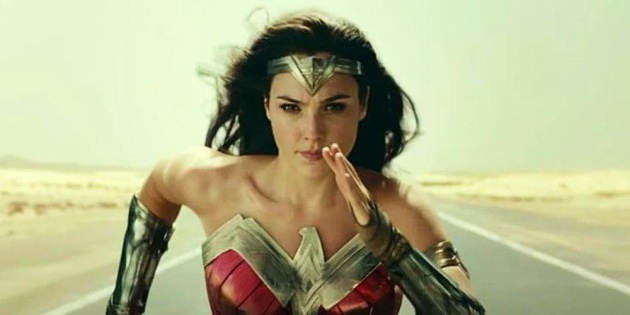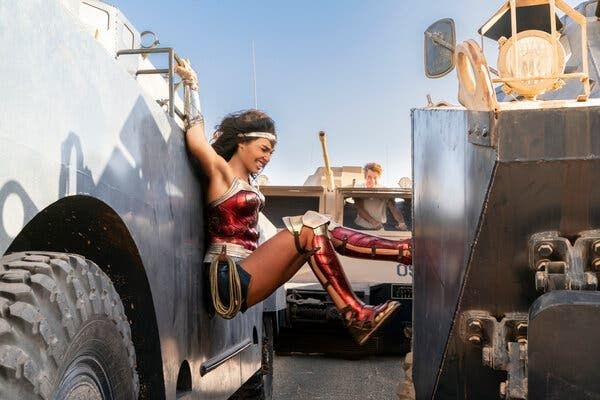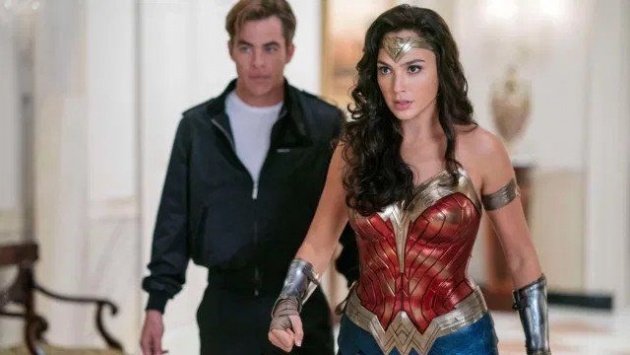
Pictured: 'Put me and Ethan Hunt in a foot race and let's see what happens.' Diana Prince (Gal Gadot) aka Wonder Woman races to the rescue in a scene from the superhero sequel, 'Wonder Woman 1984' co-written and directed by Patty Jenkins. Still courtesy of Warner Bros.
How disappointing must it have been for co-writer-director Patty Jenkins not to see her superhero sequel, Wonder Woman 1984 in movie theatres in the summer of 2020? The commercial success and audience love shown to her 2017 movie Wonder Woman inspired her to make a follow-up that asks different questions. Jenkins really pays homage to the television series starring Lynda Carter that ran from 1975 to 1979 but does so on a scale that can only be done in a movie. While other big budget movies were moved to 2021, Jenkins allowed her sequel to be released simultaneously in theatres and on home streaming in December 2020, just before the mass closure of movie theatres across Europe. The audience response to the movie has been mixed – if you trust Rotten Tomatoes. The cinema box office numbers really don’t tell the full story either. According to Box Office Mojo, its current international gross is $118,200,000, but it hasn’t opened in a number of territories yet, and in the United States, its box office isn’t reported accurately.
Still, Warner Bros, the studio that released Wonder Woman 1984, has commissioned Jenkins to direct a third Wonder Woman movie. Moreover, Jenkins has been signed to direct a Star Wars-spin-off movie, Rogue Squadron. She also has a biopic of the Egyptian queen Cleopatra (famously played by Elizabeth Taylor) in development, with Wonder Woman star Gal Gadot attached; a Macedonian actress with box-office recognition was not available.
Still, even if Wonder Woman 1984 does not turn a huge profit for Warner Bros, it does give the company a ‘must-watch’ title to see on its new streaming platform, HBO Max, which could drive up subscriptions (12.6 million as of December 2020, some way behind Disney +’s 74 million subscribers worldwide). Moreover, in spite of its Rotten Tomatoes score, it is a fun movie. As a character, Wonder Woman develops – by the end, you’ll believe a woman can fly (well, you’ll accept it anyway). The nod to Superman – The Movie and its famous tag line is intentional.
Wonder Woman 1984, co-written with Jenkins by Geoff Johns and Dave Callaham, obeys some of the rules of movie sequels: give the audience some of what they had last time, double the threat and explore the hero’s vulnerability. Jenkins adds something from episodic television: give the movie a moral theme, in this case, be careful what you wish for. Diana Prince’s wish brings back her late lover, pilot Steve Trevor (Chris Pine) albeit in another man’s body. The audience and Diana see Steve but really it is another guy who has gone to sleep or something.
It begins with a prologue that is a sop to fans of the 1941 comic book on which the character is based. Young Diana (Lilly Aspell, reprising her role from the 2017 original) takes part in an Amazonian Pentathlon event. This sequence is designed entirely for a young audience, which is not a bad thing, as she goes up against women much taller and more athletically built than herself. The competition involves her running, climbing a pole, jumping from tree stump to tree stump, leaping onto a horse and firing arrows at a target while on horseback. Diana outpaces the opposition – she is represented by a blue flag as the race progresses; it unfurls to represent her place in relation to the other competitors. However, she is knocked off her horse. Nevertheless, she finds a shortcut – a drain down which she slides – that enables her to remount her horse and reach the finish line ahead of the others. Only she is not allowed to cross it and is given a strong reprimand by her aunt Antiope (Robin Wright) for not playing fair. Diana is naturally disappointed but learns the important lesson of not accepting any shortcuts in life.
So why is the film set in 1984? The year is the title of George Orwell’s famous novel about the surveillance state and also the year that the original Supergirl movie was released. In Jenkins’ film, there is a different message being broadcast from television screens, not ‘Big Brother is Watching You’ but ‘invest in Black Gold’. The man behind the not very slick advertising campaign is Washington DC based businessman Maxwell Lord (Pedro Pascal), who is to this film what Lex Luthor is to Superman. Pascal is an actor with a growing reputation, best known for playing the title role in the Star Wars-inspired Disney + series, The Mandalorian, in which he appears shrouded in armour as a Boba Fett-style bounty hunter. Physically, he reminds me of Jeremy Renner, that is, he’s not everyone’s idea of a movie star, but he might just be one. Max Lord is, as we discover, a bit of a chancer. His company has no real assets, and he seeks new investors to pay the old ones, much like Charles Ponzi did in 1919. His principal investor, Simon Stagg (Oliver Cotton) is upset, but Max has a plan – and also a young son, Alistair (Lucian Perez) who turns up at his mostly vacant office to spend quality time with his dad.
Meanwhile, Wonder Woman herself (Gal Gadot) is doing her speedy ‘saving people from being hit by cars and tackling petty crime bit’ – so it must be her lunch hour. Her alter-ego, Diana Prince, has a job at the Smithsonian in the archaeology department. She makes the acquaintance of a new colleague, Barbara Minerva (Kristen Wiig), knowledgeable but socially awkward and barely noticed by her co-workers. (It is 1984, so the attitudes towards gender are retro.) No one will go to lunch with her, but Diana pledges to do so.
Diana swings into action (literally) during a robbery at a shopping mall. Identically moustached thieves hold up a jewellery store, not for the merchandise on display but for the artefacts in the backroom. These include a rare stone with – you guessed it – magical powers. A Dreamstone no less: whatever you wish for when touching it will come true; however, but you will lose something as a result. Diana (again – she must be on another lunch break) tackles the robbers garbed in full Wonder Woman outfit, trapping them with her glowing and amazingly extendable lasso of truth and swinging through different parts of the mall like Spiderman. At one point, she even stops to wink at a little girl before disappearing. As far as the media is concerned, there is no speculation about the identity of the woman who apprehended the robbers. Instead, the news reports tell us that the piece the robbers were trying to steal has been referred to the Smithsonian to be checked out. The inference is that the jewellery store was dealing in stolen goods. But where did the Dreamstone come from? (The answer is an earlier DC comic, where it was wielded by Doctor Destiny.)
Max makes an unexpected visit to the Smithsonian, in particular to meet Barbara who has been tasked with examining the Dreamstone. Even though he has no real wealth of his own, he pledges to support the archaeology department and pays for a party to be held to showcase their work. Diana is suspicious. In one scene, she saves Barbara from an abusive man who makes a pass at her at night after work. The man was about to get violent when Diana intervenes. During the party, Max steals the Dreamstone, but Diana also succumbs to it. She has no interest in the men who ask her for dates, rebuffing them with a firm no. But she misses her Steve. At the party, he miraculously appears.
Diana is naturally pleased to see him but how has he come back to life in the 1980s? Steve explained that he woke up in an apartment he didn’t recognise. One supposes the man whose body he possessed had an invite to the Smithsonian party. Really, you wonder, that is a very stretched invitation list. At any rate, he takes Diana back to his new apartment and tries to adjust to 1980s attire, including figuring out how to wear the ‘man bag’.
Long story short: Max decides to wish that he become the Dreamstone himself, taking its immense power. He can get anyone to wish anything they want, but he takes something from them, including oil reserves and control of the White House. Meanwhile, Barbara exercises a wish of her own. She becomes more confident, more powerful, tackling that abusive creep who makes a second pass at her. She expresses a wish to become an apex predator and becomes Cheetah, complete with a tail.
For those (like me) who have visited Washington DC, it is fun to see the parts of the city that you remember, including the metro station with its futuristic interior. Diana and Steve visit the Air and Space Museum, where they commandeer an aircraft to pursue Max Lord who has headed for the Middle East. Steve doesn’t have a passport so they cannot travel conventionally, though you think (afterwards): he’s occupying someone else’s body; if that guy has an invite to a Smithsonian party then he’s probably got a passport as well.

Pictured: 'Don't crush my Steve!' Diana Prince (Gal Gadot) puts her back into it in an action sequence from the superhero sequel, 'Wonder Woman 1984', co-written and directed by Patty Jenkins. Still courtesy of Warner Bros.
The big set pieces take place in Egypt, the White House and at a television broadcast facility. In the first sequence, Max has granted the wish of his Egyptian host to separate him from his people but takes both his host’s oil reserves and his security detail, whom Diana and Steve try to stop as they travel in a convoy – the sequence is almost a homage to the 1981 film, The Road Warrior, otherwise known as Mad Max 2. Diana also saves two young children from being hit by a vehicle. At the White House, Max gives the President a large nuclear arsenal, which in turn triggers a response from the Soviet Union. In return, he takes the President’s power. In the reception area, Diana fights Barbara and discovers that because she wished for Steve, her powers are vanishing. At the television station, Max broadcasts to the world, stating he will grant their wishes, knowing he will take everything they have. Diana realises that to stop him and Cheetah, she will have to give up Steve. After appropriate farewells, he disappears behind a pillar, never to be seen again.
Jenkins also introduces the silliest idea from the comic book: the invisible plane. Diana can make the plane that they steal from the Museum literally invisible – Steve eventually figures out how to fly a fighter jet – but it is still visible on radar. The excursion gives Diana a taste for flying and darned if she does not do so at the film’s finale, wearing the armour of the famed Amazon warrior, Asteria, which takes a real beating from Cheetah.
Wonder Woman 1984 distinguishes itself from other comic book movies in its finale. Diana does not defeat Max and Cheetah through brute strength. Instead, she asks the people of the world to renounce what they have wished for, which would otherwise lead to death and a nuclear apocalypse – the other trending topic of the early 1980s (remember War Games?) For some viewers, this may be corny, but one of the reasons I really warmed to Superman – The Movie is because Superman also saves the world in a non-violent manner. He cannot model values to aspire to unless they are different to those of the people whom he saves. Thus Diana takes a similar approach as characters sense what they have lost. She has also made a sacrifice herself.

Pictured: 'Do you think we should have left the White House tour?' Steve Trevor (Chris Pine) and Diana Prince aka Wonder Woman (Gal Gadot) in a scene from the film, 'Wonder Woman 1984', co-written and directed by Patty Jenkins. Still courtesy of Warner Bros.
There are two codas. The first takes place at Christmas and involves Diana meeting the man whose body Steve ‘borrowed’, now adopting his dress sense. The second involves the saving of more people – and a surprise cameo.
The action sequences are entertaining, aided by excellent stunt work and visual effects. Gadot, who speaks her lines with her Israeli accent, is suitably otherworldly and a straight woman to Wiig’s Barbara. At no point is either woman shown in a sexualised manner, though, at one point, Barbara wears a figure-hugging outfit to accentuate her post-wish transformation. Mostly the film sets up a series in which Wonder Woman can appear in any point during recent American history, making this one of the more flexible comic book franchises. Gadot totally owns the role.
Reviewed at Vue Cambridge Screen Two, Wednesday 23 December 2020, 18:10 screening.



